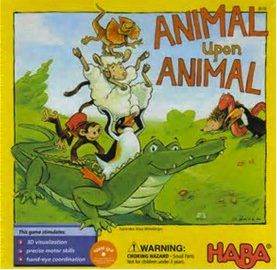Animal Upon Animal
For this month I am reviewing Animal Upon Animal, designed by Klaus Miltenberger and published by HABA. The game is in intended for 2-4 players and is recommended age is 4 and up. Each game lasts about 15 minutes. This was a recommendation from my twitter feed (@therpgacademy) when I had asked for game ideas to play with my boys (JG just turned 7, Jacob is 5 going on 6).
Words From the Boys:
John-Gabriel – “I like stacking the animals because you never know when they are going to fall all by themselves.”
Jacob – “I like to knock them down.”
Review
Animal Upon Animal is a super-simple dexterity game. The wooden game pieces are are well-crafted and colorful, each with a distinct animal shape.
There is a larger piece that looks like a crocodile that is sat out to start the game.

The first player rolls a custom d6 and takes an action based on the result. A single dot means they take any one of their animal pieces and attempts to stack it on top of the crocodile (or later previously stacked animals). Two dots means you do the same with two animal pieces. A hand symbol means you give one of your pieces to another player (your choice) and they must place it on the stack. A crocodile result means you take one of your pieces and place it to either end of the starting crocodile piece. This extends the ‘base’ and gives subsequent turns more room to play out. There is also a question mark symbol which means the other players get to decide which of your current animals you have to attempt to stack.
The game play is just that simple. Stack your animal pieces on the base and on any others already played. The first player to run out of animal tokens wins. Now, of course, sometimes the animal pieces fall which is called a collapse. If one or two animals fall off, the active player takes them and adds them to their pool of animal pieces. If more than two fall off, the active player takes their choice of two of them and the rest are put away into the box and out of the game.
This creates the two types of strategies. (similar to Jenga, really)
-
Basic – Play your piece so it doesn’t fall.
-
Advanced – Play your piece so it doesn’t fall AND in a way that it makes it more difficult for the next player to go successfully.
Final Thoughts
I find Animal Upon Animal quite simple and easy to break out and play. With my boys being so young they are kinda terrible at it, often knocking pieces off with their hands before they even start to stack. I hope as they get a little older they will improve. This game does one thing which makes me very happy. It gives the boys the ability to play on their own. In fact, it’s the only game we’re playing as a family right now that they can play by themselves. I feel like they could manage Tsuro if they tried, but they haven’t so far. But they’ve taken this game off the shelf without Mom or I and started playing just the two of them. Of course they usually just work together to build up the stack and then knock it over, but still . . . I’m happy to see them starting to play games autonomously.
At just under $20 on Amazon I would recommend this game for family time if you have kids in the 5-8 range. Though once they get older, it could become competitive, almost like Jenga where being coordinated makes it more fun not less.
Buy your copy here and support our show.
If you have a game you’d like to recommend we play as a family for a future review, please let me know.
Comments and Feedback are always welcome.
E-mail us at Podcast@TheRpgAcademy
Follow us on twitter @TheRpgAcademy
Visit our Facebook Page
Join our Google+ Community Page at: The RPG Academy
Support our show by becoming a Patron at www.Patreon.Com/TheRpgAcademy









